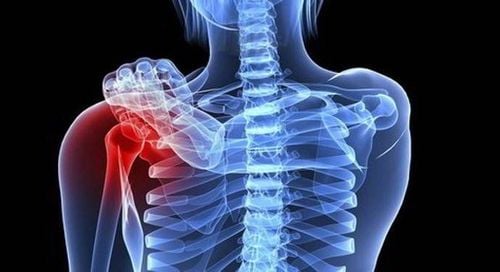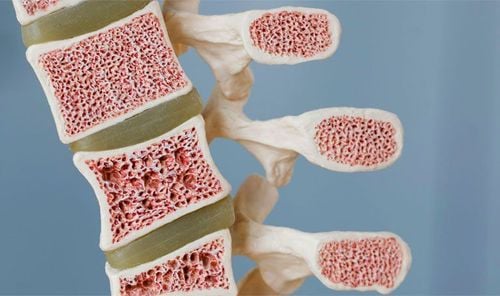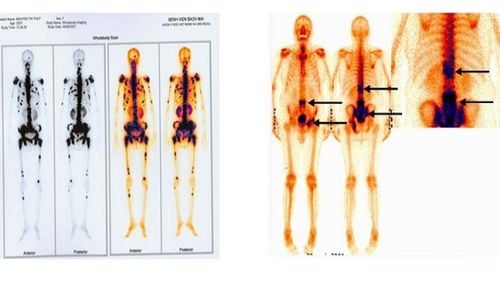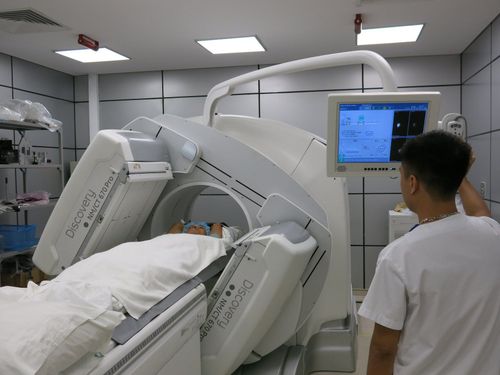This is an automatically translated article.
The article was professionally approved by Master, Doctor Luu Thi Bich Ngoc - Radiologist - Department of Diagnostic Imaging and Nuclear Medicine - Vinmec Times City International Hospital.Bone cancer is a fairly rare disease, often detected late, so the prognosis is very poor. X-ray is one of the leading advanced imaging techniques, helping to find many diseases from simple to complex. Can X-rays detect bone cancer?
1. Overview of bone cancer
Primary bone cancer that originates from cells that make bone, cartilage, and/or bone tissue. Cancer cells rapidly grow, divide, and form malignancies in the bone. Over time, cancer cells gradually invade the surrounding tissues and metastasize to other organs. Primary bone cancer usually begins in the femur, tibia, the upper end of the humerus, or the lower end of the radial bone. Accordingly, bone cancer develops in 4 stages, specifically:
Stage 1 Bone cancer cells have just appeared in bone tissue, started to grow and multiply very quickly. At this time, cancer cells have not yet invaded normal cells, causing little harm and no obvious symptoms. Very few cases of bone cancer are found at this stage, but if diagnosed and treated early, there is a good chance of a cure.
Stage 2 The melanoma begins to grow, but it is still limited to the bone and has not spread to nearby tissues and organs. If bone cancer is detected in this stage, the prognosis is still good.
Stage 3 Bone cancer is no longer limited to the primary site, but has spread to many other sites of the bone. In this stage, malignant cells grow very quickly and can spread to the lymph nodes and surrounding organs.
Stage 4 Tumor and malignant cells multiply rapidly in number, metastasize to distant tissues and organs. Treatment of bone cancer at this stage is very difficult, the prognosis is poor.
Because bone cancer often develops silently, early screening in at-risk groups is very important, helping to detect and treat early from the onset.

Ung thư xương thường khó phát hiện các triệu chứng
2. Do x-rays detect bone cancer?
To diagnose bone cancer, doctors will base on clinical and laboratory symptoms. However, clinical manifestations of bone cancer are difficult to detect and not decisive. And X-ray is one of the laboratory methods to help find this disease early. As soon as signs of bone pain appear, X-ray is the first method to help diagnose bone loss of minerals, location of bone damage, periosteal reaction,... Bone cancer will be assigned to take X-ray film straight and inclined, contralateral to look for signs of disease such as:
Location of bone damage: X-rays can determine the location of bone tumors, from which decide on the direction of treatment and evaluate the prognosis. Tumor margin: X-ray film shows the growth rate of the tumor, as well as the response around the tumor margin, thereby predicting whether the tumor is benign or malignant. Signs of bone resorption: There are many types of bone cancer, and the signs of bone loss for each type are also different, such as rodent appearance, bone cyst or fracture due to bone resorption. Periosteal reaction: The patient's X-ray image shows an irregular, thin periosteum, forming sheets and breaking the periosteum. Sometimes no periosteum is detected. Thus, X-ray shows many signs of bone cancer, but it is not possible to make a differential diagnosis and confirm it with certainty, nor is it clear about the extent of the disease. Therefore, when detecting signs of bone cancer through X-ray images, the patient needs to conduct other subclinical tests such as bone biopsy, bone scan,...
MORE : How to detect primary bone cancer?
3. Other methods of diagnosing bone cancer
In addition to X-rays, other imaging and testing techniques also support the diagnosis of disease stage, tumor location and size, degree of metastasis,... Thanks to that, the doctor can determine whether effective treatment and accurate prognosis. Some commonly used methods include:
CT Scan: Helps to detect the shape of the bone tumor, as well as the exact size and location of the tumor, and assess the invasion of the lesion into the surrounding soft tissue. PET scan: Inserts a small amount of radioactive glucose into the bloodstream to monitor the path to the bones and gives images here, helping to assess the stage of the disease Bone scan: Inserts small amounts of radiation into the blood to move them to the bones and then photographed with a scanner. Imaging is of great value in the early detection of primary bone cancer. Bone biopsy: Unlike the above imaging methods, the patient will take a sample of cells from the place where a cancerous tumor is suspected to be identified. Bone biopsy results are valuable for accurate diagnosis of bone cancer.

Chụp CT Scan giúp chẩn đoán ung thư xương
4. Other types of cancer detected through X-rays
In addition to detecting bone cancer, X-rays are also used to diagnose many different diseases, from simple to complex such as cancer. However, not all cancers can be detected with X-rays. Usually, X-rays will help find:
Throat cancer : X-rays from different positions help to diagnose evaluate the condition of the base of the skull and sinuses, or take a chest X-ray to accurately determine the status of nasopharyngeal cancer and guide treatment. Lung cancer: High-level or digital chest x-rays can be suggestive of lung cancer, but not enough to make a definitive conclusion. Sometimes the lesion is hidden by other structures, or is too small to be detected by X-rays, making it easy to miss early stage lung cancer. Therefore, people at risk of lung cancer should have periodic low-dose CT scans for early detection. Breast cancer: Mammography is the leading method of breast cancer screening today besides breast ultrasound. X-ray films or mammograms will help the doctor diagnose the extent of damage or abnormalities here, then conduct a biopsy to make more specific conclusions. Thus, the X-ray imaging method can detect primary bone cancer and find out the first signs. But for accurate diagnosis and prognosis, it is necessary to combine with other technical methods such as conducting biopsy. Cancer is a disease with increasing incidence and high mortality. Therefore, early detection and screening play an extremely important role, it is necessary to conduct periodic screening every time a year.
Vinmec International General Hospital has been and continues to be fully equipped with modern diagnostic facilities such as: PET/CT, SPECT/CT, MRI..., blood marrow, histopathology, laboratory tests. Immunohistochemistry, genetic testing, molecular biology tests, biopsies for early diagnosis of bone cancer.
After having an accurate diagnosis of the disease, the stage, the patient will be consulted to choose the most appropriate and effective treatment methods. The treatment process is always closely coordinated with many specialties to bring the highest efficiency and comfort to the patient. After undergoing the treatment phase, the patient will also be monitored and re-examined to determine whether the cancer treatment is effective or not.
Especially, now to improve service quality, Vinmec also deploys many cancer screening packages that can help customers detect cancer early before there are no symptoms, bringing a better prognosis. treatment and a high chance of recovery. Therefore, customers wishing to learn about the most modern bone cancer diagnosis techniques can contact Vinmec International General Hospital for service.
Please dial HOTLINE for more information or register for an appointment HERE. Download MyVinmec app to make appointments faster and to manage your bookings easily.













